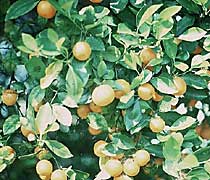


Home
Flowers &
Indoor Plants
Fruits & Nuts
Ornamentals
Vegetables
Special Topics
Resources
Glossary

|
Tangerine Citrus reticulata (sit-rus reh-tick-u-lah-tuh) 


Click on thumbnails for larger image. |
 |
What about it? The tangerine is a member of the Citrus genus along with oranges, grapefruits, tangelos, limes and lemons. This small, orange-like fruit is easy-to-peel and full of seeds. It has a deep-orange color and a pleasantly strong aroma and taste. The trees are small and attractive. Their growth is more upright than many of the Citrus genus, but like the other Citrus, the foliage is a good quality evergreen and the flowers are fragrant. What is it used for? Tangerines are generally eaten fresh, although they can also be used in juice and marmalade. Where does it gmw? How do we grow it? Like the other Citrus, we cannot grow tangerines in the Northeast. Tangerines prefer a southern climate with light, welt-drained soils that are moist but not wet. Full sun is necessary, as is supplemental watering in hot weather. A sheltered location from prevailing winds is desirable. Tangerines should be planted where their good quality foliage and beautiful fragrance can be enjoyed. What are its primary problems? Tangerines have a large pest and disease range including the black aphid, scales, leaf rollers, mealy bugs, and thrips. Bacterial and viral diseases also occur, such as citrus tristeza. Cankers can also cause problems. How do we harvest and store it? Tangerines are usually hand picked and handled with gloves. Gardeners either snap fruit off the tree or clip fruit with pruners. Cool temperatures may be used to keep the fruit for several weeks.
© Copyright, Department of Horticulture, Cornell University. |